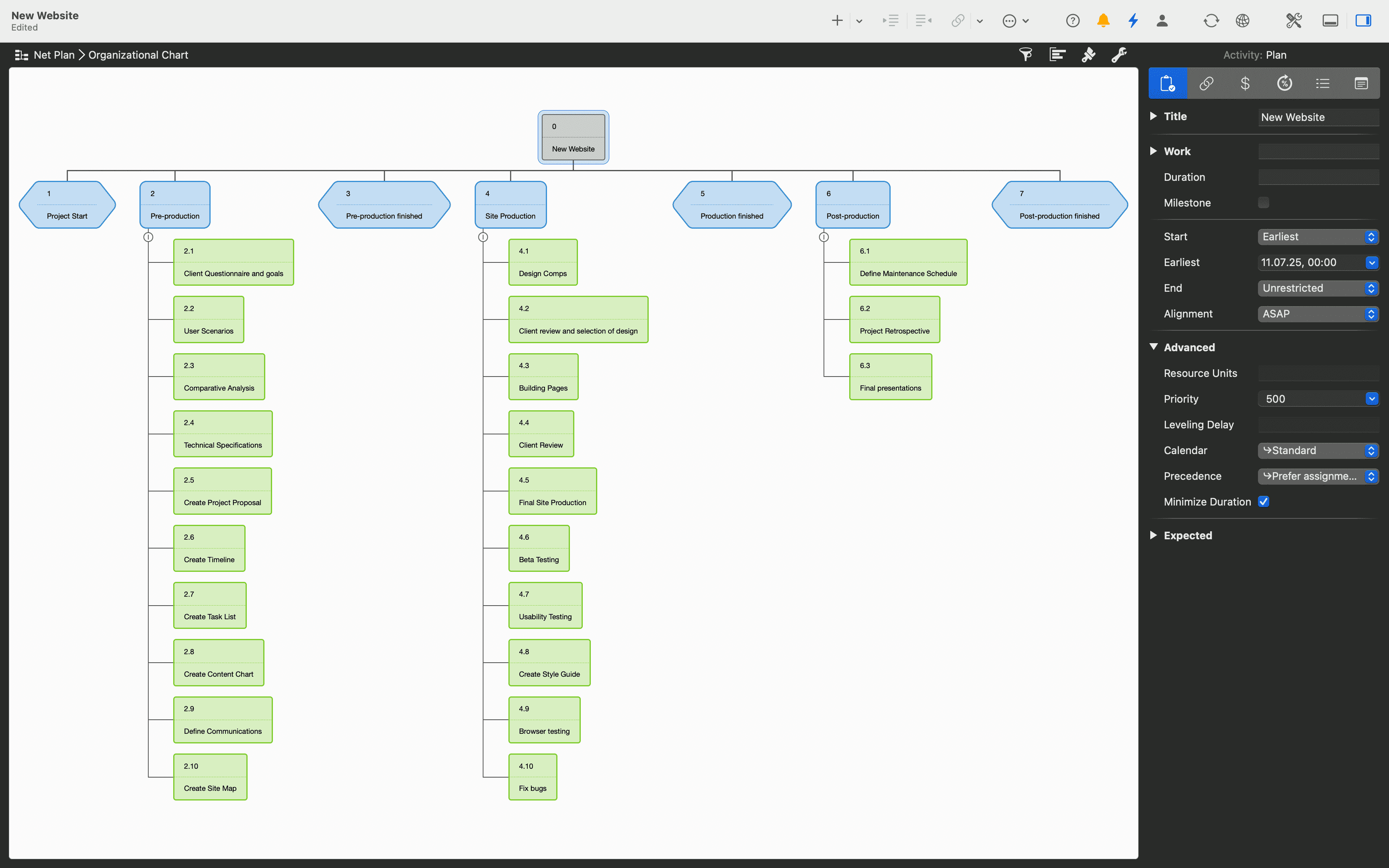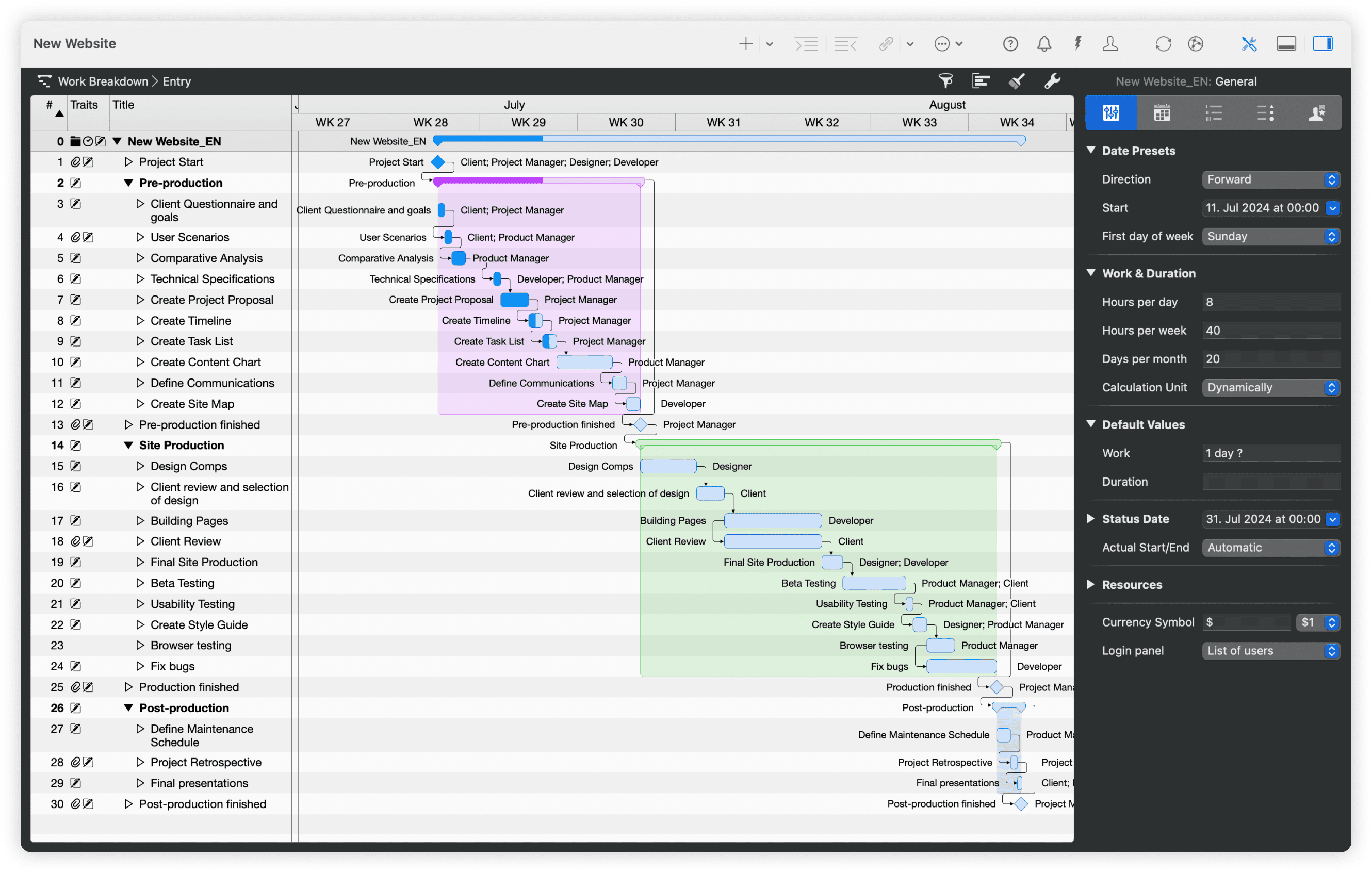¿Cuál es la diferencia entre la Estructura de Desglose del Trabajo, el Plan de Proyecto y el Cronograma del Proyecto?

Si eres nuevo en metodologías de proyectos, te enfrentarás a numerosos términos y definiciones que parecen similares. ¿Cuál es, por ejemplo, la diferencia entre una estructura de desglose del trabajo, un plan de proyecto y un cronograma de proyecto? Resolvamos la confusión.
Navega rápidamente a tu método deseado:
Estructura de Desglose del Trabajo (WBS)
Cronograma del Proyecto
Plan de Proyecto
Lamento decepcionar cualquier expectativa de una respuesta breve: Aunque los tres términos a veces se utilizan indistintamente, no son sinónimos y, por lo general, se refieren a herramientas de gestión muy diferentes.
¿Sabías que Merlin Project es perfecto para trabajar con la Estructura de Desglose del Trabajo? ¡Prueba Merlin Project gratis durante 30 días!
¿Por qué “por lo general”?
No existe una definición uniforme de ninguno de los tres términos. Dependiendo de la metodología de gestión de proyectos que sigas, se pueden asociar significados distintos. Muy bien podría suceder que en un contexto se defina un plan de proyecto de una forma específica y en otro contexto signifique algo diferente. Con esta advertencia, la distinción presentada en este artículo se aplicará a la mayoría de las circunstancias.
Estructura de Desglose del Trabajo (WBS)
La estructura de desglose del trabajo (WBS, por sus siglas en inglés) es el núcleo de la planificación del proyecto. Los jefes de proyecto usan la WBS para dividir el proyecto en elementos controlables. Es una representación visual y jerárquica de todo el trabajo necesario para completar el proyecto. Dependiendo del tamaño del proyecto, la descomposición puede incluir subproyectos, entregables y paquetes de trabajo.
Los paquetes de trabajo representan el nivel más bajo de la planificación y consisten en actividades asignadas a diferentes personas. Varios paquetes de trabajo juntos dan lugar a entregables, que podrían formar subproyectos que en conjunto conforman el resultado final del proyecto.
No se listan componentes de tiempo ni dependencias en una WBS para mantener un enfoque claro en el trabajo a realizar. Se debe crear la WBS antes de un plan de proyecto detallado, pues sirve como base para estimar los recursos necesarios y para elaborar un cronograma de costos y tiempos. Lo que no se menciona en la WBS no formará parte del alcance del proyecto y, por lo tanto, no se entregará.
Cronograma del Proyecto

Todo proyecto necesita un cronograma. Sin un cronograma sólido, tu proyecto no tendrá éxito.
El cronograma del proyecto comunica no solo lo que se necesita hacer para completar el proyecto, sino también cuándo debe hacerse. Proporciona una visión clara de qué trabajo debe realizarse, quién lo llevará a cabo, qué recursos son necesarios y en qué período de tiempo debe completarse. De esta forma, el cronograma genera una línea de tiempo e indica cuándo se completará el proyecto en su totalidad.
Los jefes de proyecto suelen utilizar software de gestión de proyectos para integrar todos los datos en un archivo dinámico único, que luego puede actualizarse según cambios en los recursos y requisitos durante el transcurso del proyecto.
Para comenzar a programar un proyecto, primero debes hacerte tres preguntas:
- ¿Qué se necesita hacer?
- ¿Cuándo se hará?
- ¿Quién lo hará?
Usa la WBS como base. Observa todas las actividades diferentes y determina el tiempo y el esfuerzo necesarios para completar cada tarea. Luego, pon las actividades en orden cronológico y asegúrate de considerar las dependencias entre distintas tareas. Algunas no pueden comenzar hasta que otras estén terminadas. Finalmente, asigna los recursos necesarios.
Planificar el cronograma de un proyecto es una de las partes más difíciles de la gestión de proyectos, pero es extremadamente importante. El cronograma del proyecto es una lista de verificación inestimable para que el jefe de proyecto mantenga el proyecto encaminado.
Plan de Proyecto
Un plan de proyecto establece un marco general que guía toda la planificación posterior. Es un documento formal aprobado que define cómo se ejecutará, monitoreará y controlará el proyecto. Su principal propósito es documentar los supuestos y decisiones de planificación, facilitar la comunicación entre las partes interesadas del proyecto y documentar los objetivos aprobados de alcance, costo y cronograma. Generalmente, el plan se crea como un documento de texto con algunas ilustraciones para visualizar aspectos clave.
Aspectos importantes que suele cubrir un plan de proyecto:
- Metas y objetivos
- Alcance del proyecto
- Hitos y línea de tiempo
- Organización del proyecto, roles clave
- Plan de costos
- Plan de gestión de la calidad
- Plan de recursos
- Gestión de las partes interesadas
- Gestión de la comunicación
- Gestión de cambios en el proyecto
- Enfoque de gestión de riesgos
- Descripciones de herramientas, tecnología y técnicas
El equipo del proyecto y sus principales partes interesadas deben ponerse de acuerdo y aprobar el plan de proyecto.
Conclusión
Como se ha explicado anteriormente, la estructura de desglose del trabajo, el cronograma del proyecto y el plan de proyecto son herramientas de gestión distintas y, por lo general, no se refieren al mismo concepto. Sin embargo, puesto que no existe una definición uniforme para ninguno de estos términos, asegúrate de que todos estén alineados cuando hables de la WBS, el plan de proyecto o el cronograma del proyecto. Es una frase común pero cierta: La comunicación clara es esencial para el éxito de un proyecto.
Este artículo fue actualizado por última vez el 11 de marzo de 2025.

